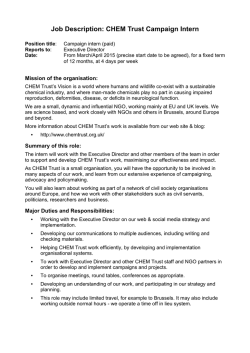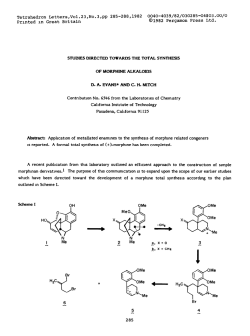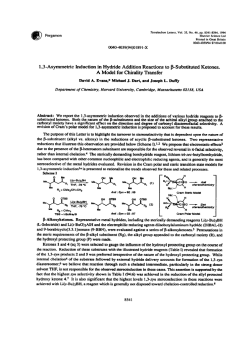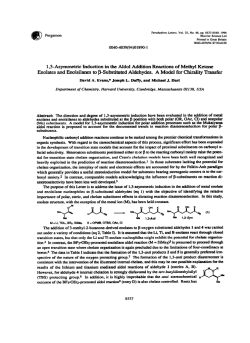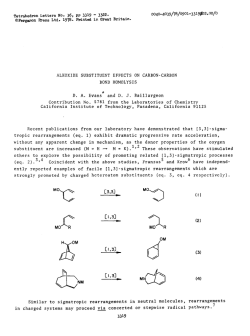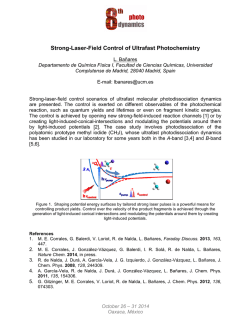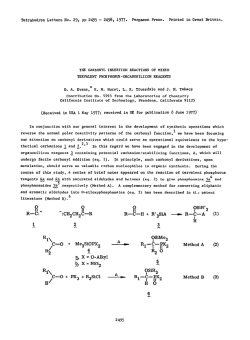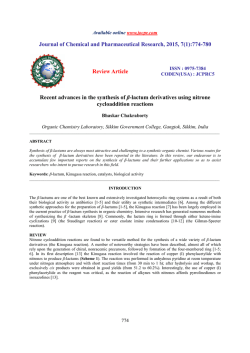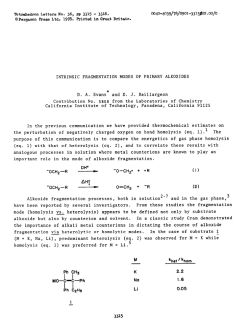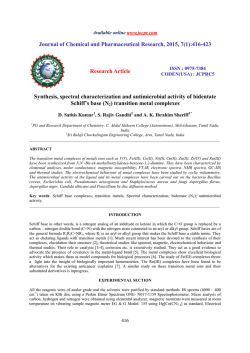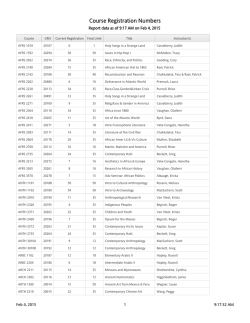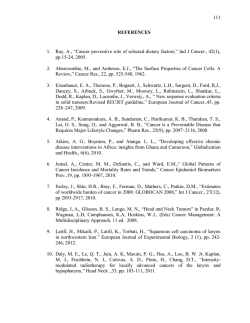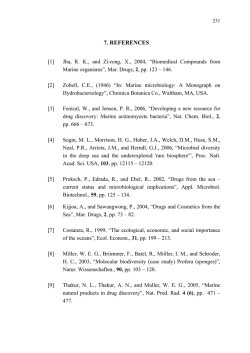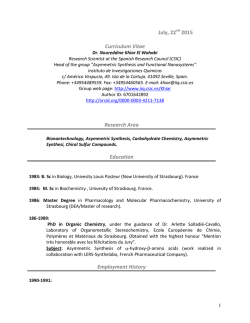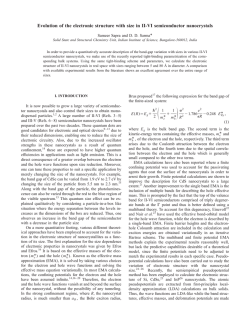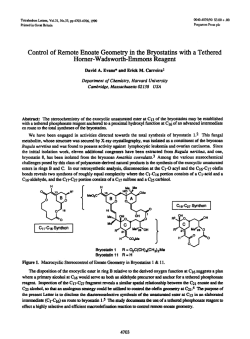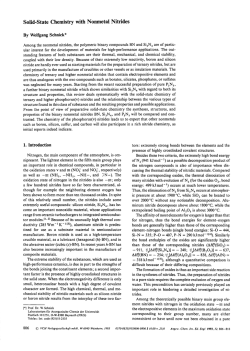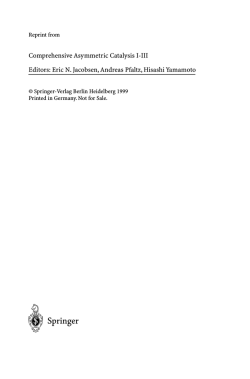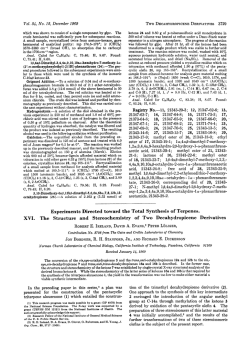
Tetrahedron Letters,Vol.27,No.49,pp 5939-5942, 1986 0040-4039
Tetrahedron Printed Letters,Vol.27,No.49,pp Great Britain in THE DIRECTED 5939-5942, REDUCTION OF EHYDROXY David A. Evans* 1986 KETONES and Kevin 0040-4039/86 Pergamon EMPLOYING $3.00 Journals + .OO Ltd. hie@HB(OAc)S T. Chapman Department of Chemistry Harvard University Cambridge, Massachusetts 02138 Abstract: borohydride The diastereoselective reduction of a range is described. In all cases, the anti 1,3-dial Chemical valuable such reactions which in stereoselective reactions propagated related wherein during studies agent MeQNBH(OAc)3 be actively I-3 course directed We have stereochemical the on the may synthesis. of acyclic Bhydroxy ketones diastereomer is the principal information of olefin from hydrogenation. hydroxyl-directed hydride by recently substrate functionality focused our attention hydroxyl-bearing 1 In the reduction present have proven on the stereogenic Letter of acyclic with triacetoxyproduct (eq I). centers ketones be using of might we wish to report Bhydroxy to development some the be of our reducing (eq 1). Me,NHB(OAc), (1) R R CH,CN I HOAc Diastereoselection20-50 It has been temperatures or 2-heptanone.4 with in generated with in this As a first might also several months.7 infrared spectra has spectral abbreviated times, several area, 5 Since and hydride. properties objective, description previously hydrolysis freely combustion of the synthesis 6 The mp 96.5 -98’ we soluble chose analysis of this to fully reagent 5939 reduced under mild conditions gained from these cases fully of choice C, which CHC13 consistent suggested is stable been that we with aspects which has been at room indeed the IS In of these triacyloxyborohydride characterized and numerous as acetophenone by Gribble.bb mechanistic characterized reagent verify follows: first and have in CH2C12, elevated been synthetic acyloxyborohydrides at such postulate the even ketones have a stable, studies. solid, products,9 The reagent, in both counterion BubNBH(OAc)3, simple information a mechanistic to produce reported ketones stereochemical interested hygroscopic and completely Bhydroxy The we sought in metal and NaBH(OAc)3 to reduce reduction, we were a colorless, both fail cyclic NaBH(OAc)j. be utilized is MebNBH(OAc)3, homogeneous that reaction a hydroxyl-mediated studies reactions. which documented In contrast, situ consistent pursuing well or prolonged :1 were other indicated developed temperature only dealing common structure. for by their with a solvents, An 5940 Tetramethylammonium was charged with The benzene. dropwise was 15 min. white semisolid vacua to give 3.34 10.8 g (121 mixture over washed Anal. The system does range of not HOAc MHz, I:1 acetic the Table, high levels bearing determined these keto of that esters intermediate are not where diketo the double below. L&and intermediate hydride delivery course exchange We bond but is actually good for the presume proximal that a-methyl m Entry postulate is -not conjugated reductions substrate alkoxydlacetoxy a stronger and borohydride hydride donor than the which reactton mira). (Entries from proceeds the distal undergolng only capable an it IS related & enoiborohydride reduction. of illustrated affords mtramolecular borohydride.‘l OH Minor degree Finally, via the transition states -iabile borohydride ligands is not m hydroxyl- In comparison, through as 2.3) also exhlblt configuration. reduction. the parent such As illustrated Me4NBH(OAc), HOAu’MeCN I’B medium acids and an impressive adducts center this r R E IH, BI-J), A solvent be ratlonahzed hydroxyl The 23.24; Table. Bronsred (vlde __-. m either undergoes to the carbonyl may added overmght 55.63, m the induction reduction dried 6 4.4 (br, 6 172.60, diastereoselectlon asymmetrlc this and second, reduction srereocenters that was 3 h, and filtered. First, (-40” C); and and syn aldol 10 also distilled acid H, 8.39. reasons. anti filter ppm (d, 18, BH, JBH = 136 Hz). following actual acetic for CDC13) is illustrated of reaction the MHz, a Schlenk 300 mL of freshly ether, study the with (300 IMHz, CDC13) C, 45.64; employed both dlstilled 6 co.71 Found m this levels that must of these between substrate-bound chosen Illustrated reduced. The stereochemlcai both the ester of freshly m facllltarmg Interest One overrides the was exhibit reduction. Included and stirred C; 1H NMR reference) H, 8.43; equipped of anhydrous temperature, 13C NNlR (75.5 temperatures to be important reductions ant1 ketones reactlon It IS of particular stereocenter noteworthy hydroxy lower portions as external C, 45.65; flask borohydride8 mp 96.5-98.0” (s, YH, CFI3CO2B); BF3 etherate Schlenk mL (425 mmol) to ambient IOO-mL actd-acetonltrile at the of generality. five powder: for ClOH22NOgB: of acyclic freeze were 2.02 24.3 was warmed white CD3CN, Calcd. of tetramethylammonium to 10” C, and with a free-flowing (S, 12 H, (Cg3)4N), NcMR (96.3 mmol) cooled The mixture was A 500-mL Triacetoxyborohydride. OH an 5941 The diastereoselectivity analogous nonbonding to explain the high anti selectivity Several in transition observed of evidence determining. ketone herein the presumed reduction nicely complement Diasteroselective Table. Entry in transition state are relevant arguments to the mechanism of either states TS destabilize TA and TS. it relative have recently of E-hydrosilyloxy It is to the been extended ketones.l* of this reaction. First we have acids such as HOAc or metal ions such as Na+ The same requirements We have followed intramolecularity can be carried the recently must also be met to effect iigand the ketones reductions of Bhydroxy exchange by IlB of these reported syn-selective can be demonstrated acid! The selective by the fact reductions reductions.13 Time (Temp) Product 1 OH reductions out in acetone-acetic Hydroxy Ketone Reductions with Me,NBH(OAc),.lo Reactant 2 transition state Similar TA. in the reduction the presence and Me/+NBH(OAc)3. Finally, Ehydroxy ketones. via the chair-like present and have -not observed the buildup of metastable borohydrlde Intermediates. Based upon we have tentatively concluded that ligand exchange rather than hydride transfer is rate this information described pieces hydroxy 2-propanol NMR spectroscopy that interactions additional rationalized interactions that MeQNBH(OAc)3 requires or Li+ to reduce between 1,3-diaxiai easily that observed the is then presumed Ratio a Anti:Syn Yield, % b 5 h (-20°C) 96:4 86 ia h (-20-c) 98:2 92 18 h (-2O’C) 98:2 a4 30 min (+25’C)C0d >98 : 2 99 0 Me 3 Me Me Me 69 Me MB a Diastereomer ratios were determined by HPLC. b Values refer to isolated yields of major isomer of z-99% purity. c Neat acetic acid used as solvent. d NaHB(OAc)3 used as reducing agent. Representative solution the of 1 mmol indicated aqueous acetonitrile of hydroxyketone time sodium at the indicated potassium tartrate dichloromethane and washed times ternperature with with several aqueous sodium bicarbonate. methane, and combined organic The desired This Acknowledgements: National may Institutes layers aqueous are be purified research of Health. IS also acknowledged and The by flash has been Tile NIH-BRS for providing dried After it IS quenched by the for sodium the The 30 mm. combined addition with anhydrous are several sodium chromatography is then aqueous layers extracted diluted layer again times sulfate. added IS has stirred a for of 15 mL of 0.5 N mixture The organic IS back triacetoxy- at -40” C acid the reaction bicarbonate. layer supported Sirared acetic acetonitrile. stirring aqueous dichloromethane, products of 5 mm01 of tetramethylammonium 4.0 mL of anhydrous (Table), vigorous saturated extracted the with and in 1.0 mL of anhydrous saturated trated. To a solution reduction procedure: in 4.0 mL of anhydrous borohydride with is back washed with filtered, with dichloro- and concen- on s111ca gel. by the National Instrumentation Grant Scier.ce Foundation ana :!IC 1-SL5-RKC17iiY-31;\ I Program .UblR facilities. References and Notes 1. For earlier (a) Evans, (b) Evans, (c) Evans, 2. Stork, 3. Crabtree, 4. (a) For an exceilent review of borohydride reductions in acidic media Organic Preparation and Procedures Int. 1985, 11, 317-84. (b) Grabble, G.W.; Nutaitis, C.F. Tetrahedron Lett. 1983, E, 4237. 5. (a) Saksena, (b) Turnbull, 6. In the 7. After a six-month period the reagent does not completely This does not, however, lead to a drop in reduction yield 8. Banus, 9. (a) Wartik, T.; Pearson, R.K. J. Inorg. Nucl. Chem. 1958, z, 404-11. (b) Marchim, G.; Lisa, A.; Reho, F.; Liberatore, F.; Moracci, F.&l. J. Org. Chem. 1975, s, 3453. (cl Oklobdzija, Xl.; Fajdiga, T.; Kovak, 1.; Zonno, F.; Sega, A.; Sunlit, V. Acra Pharm. Juposl. 1980, -30. 121; Chem. Abs. 1981,94, 121481g. work on directed D.A.; Llorrissey, D.A.; .Morrissey, D.A.; %?orrissey, G.; Kahne, R.H.; above hydrogenation reactions see: “i1.U. Tetrahedron Lett. 1984, 2. 4637. 11.11. _1. Am. Chem. Sot. 1984, G. 3866. lI.:~l.; Dow, R.L. Tetrahedron Lett. 1985. D.E. J. Am. Chem. Davis, M.W. 3. Org. Sot. 1983, Chern. 1986, l&, 1072. 2, 2655. A.K.; !v!angiaracma, P. Tetrahedron Lett. 1983, .___ <M.D.; Hatter, G.; Ledgerwood, D.E. Tetrahedron studies (Ref. ,M.D.; Bragdon, spectral 4b, 51, the borohydride R.W.; and elemental T.R.P. 3. Am. 273. Lett, 1984,g, never fully Sot. other than 13. Kathawala, F.C., Prager, 5.; Prasad, K.; Repic, 0.; Shapiro, ,M.J.; Stabler, Chim. .Ac:a 1986, 69. YS3-YO5 ant; references reported therein. (Received in USA 3 SeptemBer Chern. 1986) Commun. 1986, for all compounds Anwar, C.F. acetic acid. 23116. For comparisons of reactivity of acyloxyalkoxy borohydrides see: (a) Hirao, A.; Itsuno, S.; Owa, &$.; Nagami, S.; Uochizuki, H.; Zoorov, H.H. .4.; Niakahama, Yamazaki, N. J. Chem. SW. Perkin I 1981, 900. (b) Uasipuri, D.; Sskar, A.; Konar, S.K.; Chosh. A. Indian 3. Chem. 1982, 218, 212-5. 12. Nutaitis, 5449. Satisfactory Sot. obtained 1952,2, C.k.; characterized. dissolve in solvents or stereoselectivity. Chem. were Gribbie, il. .A.P.. J. Chem. analyses were see: 6005. 10. S.; Davis, data Cobb, Jr., species 2, 26(49). -- reportea. S.; 831-332. R.S.; Tidier, L. Helv.
© Copyright 2026
